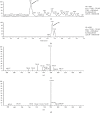A Case Report of Accidental Intoxication following Ingestion of Foxglove Confused with Borage: High Digoxinemia without Major Complications
- PMID: 31871798
- PMCID: PMC6906804
- DOI: 10.1155/2019/9707428
A Case Report of Accidental Intoxication following Ingestion of Foxglove Confused with Borage: High Digoxinemia without Major Complications
Abstract
Foxglove (Digitalis purpurea L.) leaves are frequently confused with borage (Borago officinalis L.), which is traditionally used as a food ingredient. Due to the presence of the cardiac glycosides, mostly digitoxin, foxglove leaves are poisonous to human and may be fatal if ingested. A 55-year-old Caucasian woman complaining weakness, fatigue, nausea, and vomiting was admitted to the Emergency Department. Her symptoms started following consumption of a home-made savory pie with 5 leaves from a plant bought in a garden nursery as borage. Digoxinemia was high (10.4 μg/L). The patient was admitted to the cardiac intensive care unit for electrocardiographic monitoring. Two days after admission, a single episode of advanced atrioventricular (AV) block was recorded by telemetry, followed by a second-degree AV block episode. Plasma samples at day 11 were analysed by LC-MS spectrometry, and gitoxin was identified suggesting that this compound may be responsible for the clinical toxicity rather than digoxin. In the case of Digitalis spp. poisoning, laboratory data should be interpreted according to the clinical picture and method of analysis used since a variety of glycosides, which are chemically similar to the cardioactive glycosides but without or with fewer cardiac effects, may be incorrectly recognized as digoxin by the test, giving misleading results.
Copyright © 2019 Maria Silvia Negroni et al.
Conflict of interest statement
The authors have no conflicts of interest to declare.
Figures




References
-
- Brigham T., Schroder M., Cocksedge W. Good Practices for Plant Identification. Canada: Agriculture and Agri-Food; 2004.
Publication types
LinkOut - more resources
Full Text Sources
Miscellaneous

